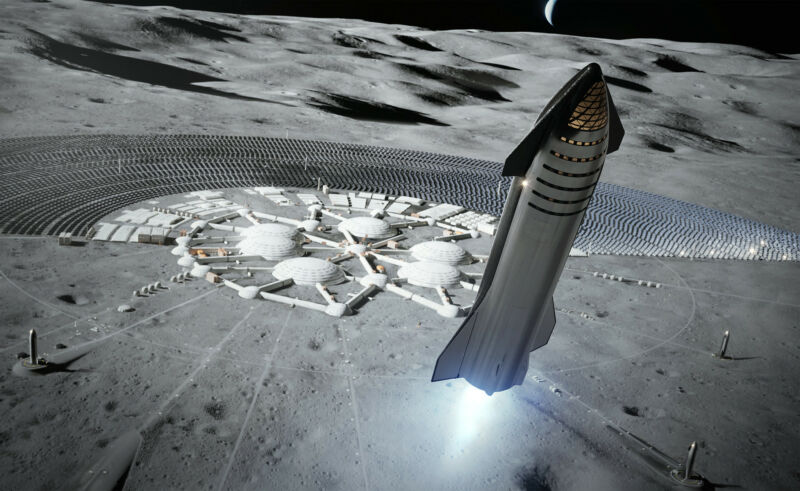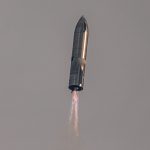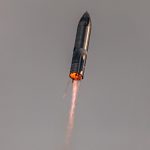NASA’s bold bet on Starship for the Moon may change spaceflight forever
- Get link
- X
- Other Apps
"It is transformational to degrees no one today can understand."

When NASA astronauts return to the Moon in a few years, they will do so inside a lander that dwarfs that of the Apollo era. SpaceX's Starship vehicle measures 50 meters from its nose cone to landing legs. By contrast, the cramped Lunar Module that carried Neil Armstrong and Buzz Aldrin down to the Moon in 1969 stood just 7 meters tall.
This is but one of many genuinely shocking aspects of NASA's decision a week ago to award SpaceX—and only SpaceX—a contract to develop, test, and fly two missions to the lunar surface. The second flight, which will carry astronauts to the Moon, could launch as early as 2024.
NASA awarded SpaceX $2.89 billion for these two missions. But this contract would balloon in amount should NASA select SpaceX to fly recurring lunar missions later in the 2020s. And it has value to SpaceX and NASA in myriad other ways. Perhaps most significantly, with this contract NASA has bet on a bold future of exploration. Until now, the plans NASA had contemplated for human exploration in deep space all had echoes of the Apollo program. NASA talked about "sustainable" missions and plans in terms of cost, but they were sustainable in name only.
FURTHER READING
NASA selects SpaceX as its sole provider for a lunar landerBy betting on Starship, which entails a host of development risks, NASA is taking a chance on what would be a much brighter future. One in which not a handful of astronauts go to the Moon or Mars, but dozens and then hundreds. In this sense, Starship represents a radical departure for NASA and human exploration.
"If Starship meets the goals Elon Musk has set for it, Starship getting this contract is like the US government supporting the railroads in the old west here on Earth," said Rick Tumlinson, a proponent of human settlement of the Solar System. "It is transformational to degrees no one today can understand."
We will nonetheless try to understand some of the ways in which Starship could prove transformational.
1. Starship ahead of schedule
Ahead of NASA's announcement on April 16, I did not expect SpaceX to receive the only, or even the largest, award from NASA this early on in the lander-development process.
About a year ago, NASA selected three different bids for a Human Landing System. Over the course of 10 months, each of the three contractors fine-tuned its design and worked with NASA engineers to explain how its lander could meet the space agency's needs. A team led by Blue Origin submitted the most conventional design, tailored to NASA's request for a three-stage lander. Dynetics proposed an innovative lander, with a nod toward reusability, but it was also sized to bring just a few astronauts to the lunar surface.
SpaceX, by contrast, submitted a version of its Mars vehicle as a lunar lander. For the last five years, SpaceX has largely self-funded development of Starship as the reusable upper stage of a massive rocket, Super Heavy. The vehicle is intended to take dozens of people to Mars at a time in a six-month voyage. Thus, Starship is massively oversized to take two or four astronauts down to the surface of the Moon. But of the three landers, it is the only one with a direct path toward full reuse.
Starship is also the most technically demanding of the three vehicles because of its size and aspirations. Among the biggest hurdles are learning to land Starship, both on the Moon and back on Earth. And to conduct missions to the Moon and beyond, SpaceX must develop the technology to refuel Starship with methane and liquid-oxygen fuel in low Earth orbit.
- This gallery of images showcases the flight of Starship prototype SN10's flight in March 2021.
- The vehicle launched from South Texas, one month after the flight of SN9.Trevor Mahlmann
- First, one engine went out.Trevor Mahlmann
- Then two.Trevor Mahlmann
- Then Starship began the process of reorienting itself.Trevor Mahlmann
- With all three Raptor engines off, it began falling. And, oh my, that smoke.Trevor Mahlmann
- Is this even real life?Trevor Mahlmann
- As the rocket neared the ground, its engines relit.Trevor Mahlmann
- Now came the tricky maneuver of reorienting itself vertically.Trevor Mahlmann
- Looking better this time.Trevor Mahlmann
- Almost there—Starship SN10 comes in for a landing on Wednesday.
- And down, if not quite safe and sound.Trevor Mahlmann
"One of the hardest engineering problems known to man is making a reusable orbital rocket," SpaceX founder Elon Musk told me about a year ago. "It's stupidly difficult to have a fully reusable orbital system."
Because there are so many technological miracles needed to validate the Starship design, I felt that NASA would not fully commit to the SpaceX vehicle as a potential lander until it had flown. Perhaps launching Starship into orbit would be enough of a technology demonstration for NASA. Or maybe SpaceX would have to land one on the Moon. This perceived need to demonstrate the viability of Starship is one reason why Musk and SpaceX have built and launched Starships at such a frenetic pace in South Texas during the last year. Only by doing, the thinking went, would NASA believe in Starship.
Instead, NASA has committed to the ambitious program even before Starship has safely landed after a high-altitude flight test. In this sense, NASA's support for Starship has come ahead of schedule.
2. SpaceX needs NASA for Mars
After seeing SpaceX launch more than 100 rockets over the last decade, what has become abundantly clear is that its engineers are now the best in the world at designing, building, and flying new and innovative rockets. The execution of the Falcon 9 program, proving out first-stage reuse, and development of the Falcon Heavy rocket attest to this.
But building great rockets is one thing. It is another thing to develop all of the other capabilities needed to ensure that humans can travel to Mars, land on the red planet, and survive there.
When it comes to in-space activities, SpaceX has leaned on NASA's expertise for Crew Dragon as part of the commercial crew program. And with respect to the kinds of technologies needed for long-duration travel to Mars, through deep space, SpaceX has limited experience—there is very little recycling of air, water, and other consumables on a Crew Dragon spacecraft. NASA, on the other hand, has been working on these problems for more than a decade with astronauts on the International Space Station.
The space agency has also been conducting studies of Moon and Mars missions for decades, said Abhi Tripathi, who worked as a systems engineer at NASA from 2000 to 2010 performing these kinds of analyses. Tripathi left NASA to work at SpaceX on the cargo and crew versions of the Dragon spacecraft until 2020, when he moved to the University of California, Berkeley.
"NASA will undoubtedly bring to bear a wealth of invaluable information, technology, and subject matter experts to help SpaceX achieve their shared goal of putting humans on Mars," Tripathi told Ars.
NASA and SpaceX collaborating this early on Starship also helps with a host of other issues not related to transportation. A government agency will be needed to facilitate the development of nuclear-based power for the surface of Mars, for example. And any human missions to Mars will raise planetary protection questions and other international concerns. Having NASA alongside SpaceX means the US government will help address all of these issues.
Suddenly, human landings on Mars about a decade from now seem a lot more realistic.
ARS VIDEO
NASA Michoud: Orion Crew Module
3. NASA bets on game-changing technology
The world has never seen a vehicle like Starship before. If successful, the massive spacecraft would open up new possibilities to NASA not before available. This is because Starship could realize the long-desired goal of rapid, low-cost reuse of a launch system.
Consider the status quo. The large Space Launch System rocket under development by NASA will be able to launch 95 metric tons into low Earth orbit. NASA and its contractors, led by Boeing, will be able to build one a year. The expendable vehicle will launch one payload, at a cost of about $2 billion per mission, and then drop into the ocean.
In terms of lift capacity, the vehicles are similar. Starship and Super Heavy should be able to put about 100 tons into low Earth orbit. However, SpaceX is already capable of building one Starship a month, and the plan is to reuse each booster and spacecraft dozens of times. Imagine the kind of space program NASA could have with the capacity to launch 100 tons into orbit every two weeks—instead of a single annual mission—for $2 billion a year. Seriously, pause a moment and really think about that.
In their decision to select SpaceX, NASA officials appeared to recognize this potential. "We were looking to see what industry partners could bring in terms of innovation and solutions," said Lisa Watson-Morgan, the Human Landing System program manager. The emphasis here is on innovation and new solutions to old problems.
"In picking the Starship architecture, NASA is helping enable a path toward a super heavy launch vehicle, in-space propellant storage, in-space refueling, and large up and down mass to planetary surfaces," said Tripathi, who has examined these problems from both NASA and SpaceX's perspective.
Put another way: if Starship is successful, NASA no longer needs to pick just one or two big things to do in space. The agency will be able to do many different things at the same time.
4. NASA funds an SLS competitor
So why is NASA funding a launch system that will directly compete with its SLS booster? That, to be clear, was not the space agency's intent. In explaining the award during a news conference, agency officials were careful to say that SLS and the Orion spacecraft remain an essential part of the Artemis architecture. But in reality, NASA may well be putting its SLS rocket out of business.
With the Human Landing System award, NASA has put its stamp of approval on Starship and Super Heavy. The launch system will eventually go into the catalog maintained by NASA's Launch Services Provider program, allowing other agency programs to procure the vehicle for missions. This could be a real boon for large, space-based telescopes that would find the large volume of Starship's payload fairing useful.
"If I were an official in one of NASA's other directorates, I would personally be dreaming up all kinds of ideas for what I can someday do with all these substantive new capabilities," Tripathi said.
In the big picture, $2.89 billion is not a lot compared to what NASA has already invested in the SLS rocket. The space agency spends that much every year in development costs for the rocket and its associated ground systems. Because the SLS rocket is funded through cost-plus contracts to major space contractors like Boeing, there is less incentive to control costs or deliver a timely product. Predictably, the SLS vehicle is significantly over budget and now five years behind its original launch date of late 2016.
All of this has led to criticisms that SLS is a jobs program. Indeed, it provides jobs in all 50 states and supports hundreds of small businesses. And perhaps this explains why Congress has steadfastly supported SLS despite its costs and delays.
By contrast, Starship is not a jobs program. Rather, it's a jobs-killer program from the perspective of Congress.
5. Is SpaceX too dominant?
SpaceX has enjoyed a remarkable string of NASA contract wins. Over the last decade, it has landed NASA awards to deliver cargo and crew to the International Space Station, launch the Lunar Gateway, supply this Gateway with cargo, and now deliver humans to the surface of the Moon.
The Artemis Program could also plausibly morph into the SpaceX Lunar Program. How? Under the current plan, a Super Heavy rocket would launch Starship to lunar orbit. Days later, an SLS rocket would launch crew inside an Orion spacecraft, which would dock with Starship in lunar orbit. The crew would transfer to Starship and go down to the Moon. After coming back to lunar orbit on Starship, the astronauts would board Orion and fly back to Earth.
But if Starship is safe for humans to land on the Moon, why would it not be safe for humans simply to launch from Earth on board the vehicle? This would save NASA the cost of an SLS plus Orion launch—about $3 billion per mission, combined—and a tricky rendezvous and docking in lunar orbit. This is probably the future of a truly sustainable lunar exploration program.
That's good for NASA and for SpaceX, but what about the other spaceflight companies? Under the (much) more expensive plan using SLS and Orion, NASA is also funding a who's who of aerospace companies: Boeing, Lockheed Martin, Northrop Grumman, Aerojet Rocketdyne, United Launch Alliance, and many, many other smaller players across the United States. Starship directly supports SpaceX, its limited number of suppliers, and... whatever company ends up building spacesuits for lunar forays.
It is therefore difficult to see a SpaceX-only exploration program winning broad congressional support for Artemis. History suggests that all of the losing contractors would urge the politicians they bolster with contributions to actively oppose the program.
And what of international partners and the geopolitical implications of this? During a confirmation hearing this week before the US Senate Commerce committee, incoming NASA Administrator Bill Nelson said expanding the coalition of nations participating in the Artemis Program was one of his big goals. Increasing the space agency's reliance on SpaceX likely would work against this.
With the low-cost, reusable Falcon 9 rocket, SpaceX has already badly damaged the commercial launch industries in Europe, Russia, and Japan. For the Artemis Program, Europe is contributing the Service Module for the Orion spacecraft. How would these officials react if NASA now says, "non merci" to that contribution because of SpaceX?
"The nation's activities in deep space remain very tied up in international policy, alliances, adversaries, and security, as well as space exploration and science," an industry source told Ars. "There are a number of foreign policy interdependencies and offsets that are managed through or impact space, generally below the surface. What does this choice signal to all of those players?"
In summary
With Starship, SpaceX has offered what appears to be the best technical solution to NASA's stated goal of a sustainable lunar exploration program. Starship would be able to take far more people and cargo to the Moon than any other solution for NASA—and it could do the job for far less money and far more often.
Furthermore, in awarding the Human Landing System contract to SpaceX, NASA has embraced a risky yet highly rewarding technology.
But whereas NASA is a space agency, its feet remain very much grounded in the political orbit of Washington, DC's beltway. Technically, Starship may be the best solution to NASA's needs. But politically, would it be? Probably not. If NASA wants to go to the Moon and beyond, it must work with a multitude of contractors and countries, at least for now.
Ultimately, physics will win out. If SpaceX can make Starship work, eventually NASA's other options for human exploration of the Solar System may come to look ridiculous by comparison. By placing an early bet on Starship last week, NASA has increased the ultimate odds of Starship's success.
For the space agency, this is an audacious and surprising play. But the potential payoff is huge. One day it may allow us to boldly go not just back to the Moon, but far, far beyond.












Comments
Post a Comment